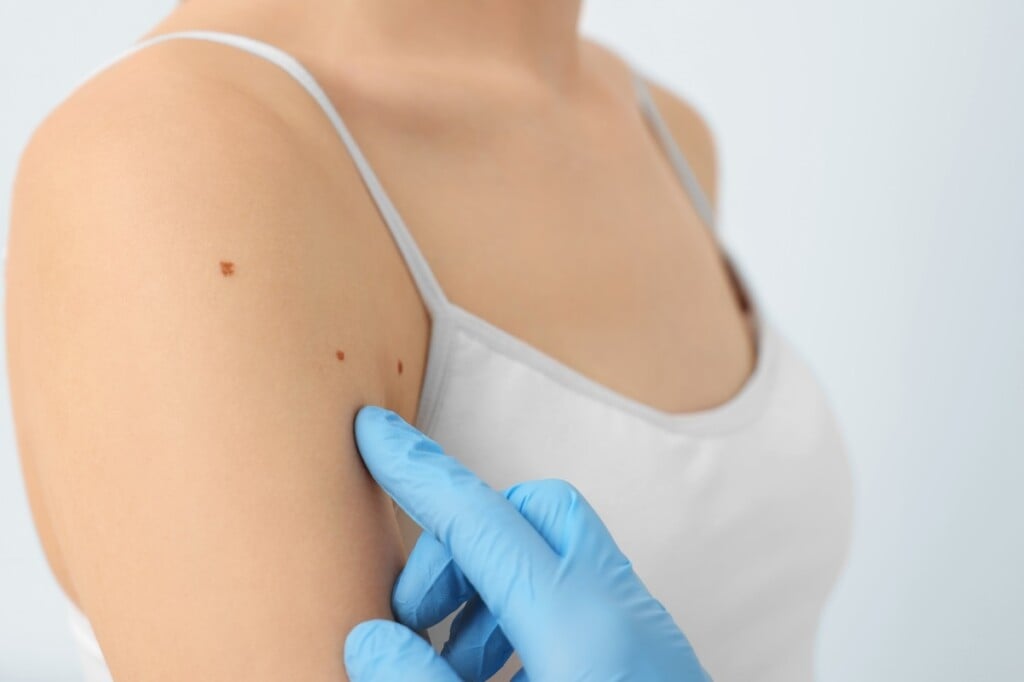The Skin You’re In
A benign bump or a cause for alarm? A Bergen dermatologist explains when to see an expert when something changes on your epidermis.

Your skin is your body’s largest organ, and it’s the most visible part of you. Exposed to the sun, the elements and other people’s eyes, it can take a lot of abuse, and it goes through some serious changes as you age. Wrinkles, age spots, increased sensitivity, more visible veins—while it may be tempting to write off all of these as inevitable symptoms of Father Time, take caution. Sometimes changes in your skin can be indications of a larger problem.
Says Michael Wiederkehr, M.D., a board certified dermatologist at the Center for Dermatology & Skin Surgery in Paramus: “It’s come more into the public eye recently that there are serious reasons to go to a dermatologist in addition to cosmetic ones.”
When should you be concerned? BERGEN talked to Dr. Wiederkehr about red flags, when to seek out a professional and some solutions that professional can offer.
Changing moles
“In general, as we get older, people get new growths, and most of those growths are probably going to be normal,” says Dr. Wiederkehr. “Unfortunately, some of them aren’t.” A new mole, or an old one changing or growing, can be a sign of skin cancer. There are three common types of skin cancer: squamous cell carcinoma, basal cell carcinoma and melanoma. Squamous cell carcinoma and basal cell carcinoma form in the upper and lower person is allergic to. Anything from a fragrance or preservative in a body-care product to metals such as gold or nickel can cause an allergic reaction. A dermatologist can test for these allergens and irritants so that the patient knows to avoid them, besides providing a detailed list of products with those irritants in them. Persistent skin irritation can also be caused by a bacterial or fungal infection. If a rash is expanding or oozing, that’s a reason to be concerned. A fungal infection will begin in one area, usually one that is warm and moist. The creases of the groin or the spaces between the toes are two examples. “The rash will slowly expand, sometimes in a semi-circle or a circle pattern,” says Dr. Wiederkehr. A bacterial infection, such as a staph infection, will spread differently. “You’ll get a patch in one area, and then a few days later a patch in another area,” he says. “You keep getting new ones.” Bacterial infections need to be treated with antibiotics, and fungal infections are most often handled with oral or topical antifungals. Hair loss layers of the epidermis, respectively, and are, according to the doctor, “much more common. If people are fair-skinned with a history of sun exposure, as they get older it’s likely they will develop one of those.” If a growth on the skin is new, scabby, bleeding and/or sensitive, it should be checked out, particularly if it’s on sun-exposed areas such as the face or neck. These types of skin cancers can usually be dealt with at the dermatologist’s office, often with Mohs surgery, which Dr. Wiederkehr calls “the gold standard” for treatment. Mohs surgery precisely removes the skin cancer layer by layer, preserving the healthy tissue around it.
Melanoma develops deeper in the skin, within the cells that give our skin its color. It’s much more likely to spread and become dangerous than squamous cell or basal cell carcinoma. “Some melanomas arise from preexisting moles,” says Dr. Wiederkehr. He explains the “ABCDs” of identifying these moles: asymmetry, border, color and diameter. If a preexisting mole starts changing, with one of its sides different from the other (asymmetry), begins to develop jagged edges instead of smooth ones (border), is uneven in hue (color) or begins to grow significantly (diameter), that’s a good sign you should see a doctor. “If you have one of those symptoms, there’s no reason to panic, but you should go get checked out,” says the doctor.
There’s something else to consider if you develop a new growth on your skin, no matter how benign—whether or not it bothers you. “Common [non-cancerous] growths patients get as they age are seborrheic keratoses, which are brown, crusty spots that can be itchy and irritating and can certainly look annoying,” says Dr. Wiederkehr. “We can freeze or scrape those off if they’re bothering someone.”
Skin irritation
Sometimes irritated skin just needs some moisturizer and time. But sometimes it needs something more. If the irritation keeps you from sleeping, persists over multiple days and isn’t soothed by over-the-counter ointments, it’s time to seek out a professional. “You may have something called contact dermatitis,” says Dr. Wiederkehr. That is an allergic reaction caused by direct contact with a substance a person is allergic to. Anything from a fragrance or preservative in a body-care product to metals such as gold or nickel can cause an allergic reaction. A dermatologist can test for these allergens and irritants so that the patient knows to avoid them, besides providing a detailed list of products with those irritants in them.
Persistent skin irritation can also be caused by a bacterial or fungal infection. If a rash is expanding or oozing, that’s a reason to be concerned. A fungal infection will begin in one area, usually one that is warm and moist. The creases of the groin or the spaces between the toes are two examples. “The rash will slowly expand, sometimes in a semi-circle or a circle pattern,” says Dr. Wiederkehr. A bacterial infection, such as a staph infection, will spread differently. “You’ll get a patch in one area, and then a few days later a patch in another area,” he says. “You keep getting new ones.” Bacterial infections need to be treated with antibiotics, and fungal infections are most often handled with oral or topical antifungals.
Hair loss
Male- or female-pattern hair loss, the most common cause of baldness, is genetic and results from testosterone shrinking hair follicles until they can’t support hair growth. There are effective medications to treat it, says Dr. Wiederkehr. “The best and most effective treatments for it are medications that block the testosterone from getting to the receptor [that causes that reaction].” You likely know if male- or female-pattern hair loss runs in your family. But, beyond that, there are other reasons to pay attention if your hair starts falling out. “Anemia, low red blood cells or certain thyroid conditions can cause hair loss,” says the doctor. Certain autoimmune conditions also can produce it. “These patients have inflammation that’s attacking the root of the hair follicles,” the doctor says. “It creates a scar. That’s called ‘scarring hair loss.’ In general, we use injections of steroid medications to treat the inflammation in the area, sometimes with topical and oral medication as well, and that allows the hair to grow back.”
“There are many causes of hair loss,” says the doctor in summary, “and many of them are treatable. Particularly if it bothers the patient, he or she should be evaluated.”

